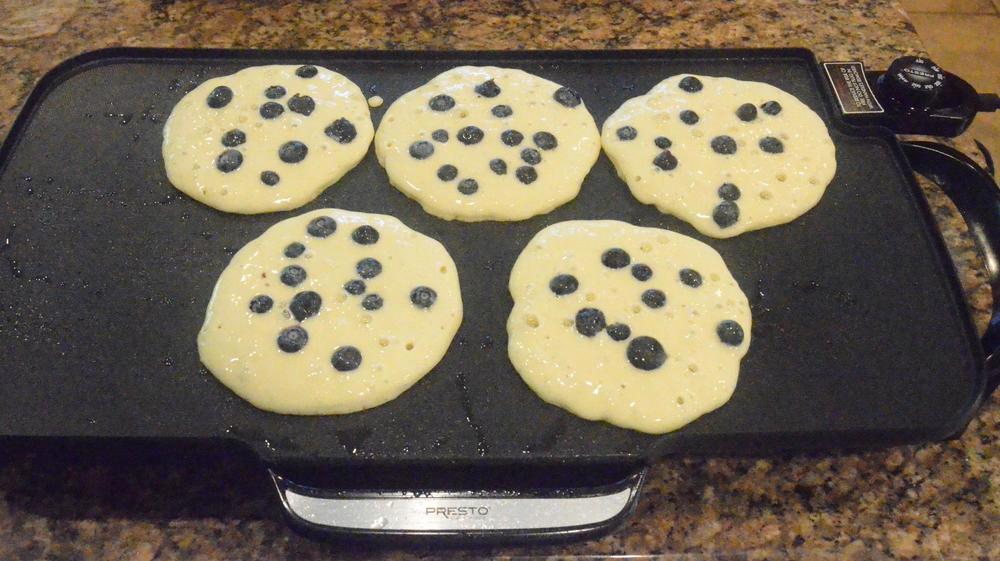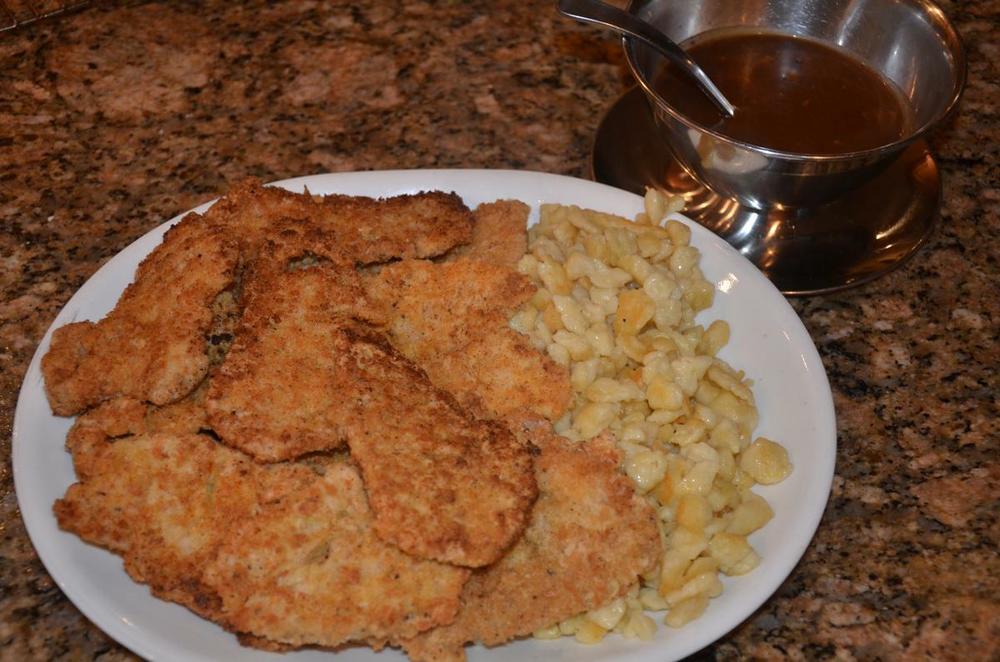-
Posts
1,653 -
Joined
-
Last visited
Content Type
Profiles
Forums
Store
Help Articles
Everything posted by AlaMoi
-
the marble is already polished - 100 grit will be too coarse. I recommend you research polishing marble and how to remove etching from marble. there are a number of alternatives.
-
temp to kill salmonela 131'F; listeria 158'F; botulism 240'F pH>4.6; e-coli 160'F; tapeworm 125'F trichinosis 137'F; campylobacter 158'F
-
I second the Luminara suggestion - saw them in a restaurant recently - they fooled me - couldn't believe they'd have real candles going . . . but they are pricey. video
-
if you have a woodworker handy - half-Lincoln logs make a dandy bin - much easier to move around/relocate.
-
looking at the video - this is not composting. this is simply drying/dehydrating food scraps. I wonder what those shrimp shell smell like when you water the plant . . . also an interesting hoot - at the video opening look at the size of the pail and the volume of material that poor soul is struggling with . . . compare that to the size of the ittybitty device bucket. I see a falsisity in motion . . . .
-
this is a batter recipe from 40+ years ago - as 'tested' by consumer reports. I also like to hand drop the berries after the pour . . . no blue batter...
-
if you're curious, there are (many) "salt sampler sets" available - just read carefully as some are "infused salts" and some are the natural salts from variously places/locales/mountains/etc. typically small qtys - 1-2 ounces - of each; small sets with 2-3 varieties to many....
-
if you can get it bone in, be sure to ask the definition. many butchers cut the meat free of the bone, then tie it back together. I find that does not produce as good a result.
-
note that dry aging beef is a topic much like how to hard boil and egg - a lot of people have very fixed opinions, which are all not the same. I've never found "an authority" that more than one person will accept as an authority - the USDA doesn't publish any how-to guidelines. places famous for dry aged beef that do reveal their 'secrets' don't do it 'the same' - so this topic frequently degenerates into a free for all. I like to age our stuff so I've researched it a bit. here's some stuff I've found you may or may not choose to believe or use: - one point to dry aging is tenderness; tough/chewy indicates to me something was not done "right" - taste testing by generally accepted 'food people' indicates dry aging past 30 days becomes a diminishing return; the flavor/taste gets funkier, to the point some don't like it 'that old' - boneless. usually not recommended; the meat dries too fast. - deckle: prime rib affectionados like this left on - fat cap: generous fat cap left on during; trimmed after - most places famous for dry aging agree on temperatures with a degree or two - places famous for dry aging do not all agree on what relative humidity should be maintained or whether it should be constant or start high/low and move to low/high. the cited numbers range from 50%-95% - the home fridge does not control humidity; a frost free refrigerator can be far to low in relative humidity - quite a few known / self-appointed experts limit home refrigerator dry aging to "several days" ==================== in your case, 17 to 10 lbs or 18 to 11 lbs = almost 40% loss - that's very high. 30% at 60 days is an oft cited number. my suspicion is that it dried too fast - more jerky than dry aged - and left 45-52-60 days was just too much. if it was deboned then dried, that would aggravate the situation even more as the fat cap and bone structure slows down the drying process.
-
what was the weight loss % wise? setting all the kitchen lore stories aside for the moment, dry aging beef takes a combination of the right temperature and the right humidity. unless the butcher has a set-up that controls both temp&humidity, odds are it simply dried out too much.
-
just like any other culture, there are some number of dishes/preps that are 'identified' as "German." if some mentions they had goulash for dinner, you're not likely to think "Oh, Portugal!" nor does one meet alot of Swedes bragging on their freshly caught homemade calamari..... I have had dishes like sauerbraten, eisbein, spaetzel, etc etc in places outside of Germany that one would not recognize as anything of the same name. slicing off a chunk of eye round, dipping it in a vinegar marinade and plating it as "sauerbraten" really doesn't work - but I've seen - errrrr 'tasted' - that done. otoh, there are a few that are more unique to a culture: using bakers ammonia for leavening . . . don't find that much outside of areas-of-Germanic-influence. "authentic" to me is a combination of the basic foodstuff plus prep plus seasonings plus presentation plus sides. a plate of sauerbraten served with sweet potato and corn - not authentic..... may be tasty, but not authentic. served with buttered&parsley boiled potato and rotkohl, that's authentic. any german dish served with iceberg lettuce - not authentic... served with "kraeuter salat", that's authentic. and the ambiguous dishes - potato salad . . . exists in both oil&vinegar and in the creamy creations - German, but regional... even 'highly identified' dishes - Schweinhaxen / Eisbein - have different regional preps. which is 'authentic' depends on where you were. "authentic" is a bit tricky to define - which probably explains why the topic is re-discussed so often.....
-
250 people have died as a result of gas explosions since 2007. all gas explosions, not only residential. 1,000 people get accidentally electrocuted every year. btw, LP stands for "liquid propane"
-
I went to school in Swabia in the 60's; did extensive European business travel 80's to 00's, and worked three years at a sister company in Bavaria. in my experience, what passes for German food in USA could not be given away in Germany to the homeless - they would not eat it. I suppose there are/were some good USA places - but for the most part it's a real joke. when there's no difference between the local diner and a German restaurant - they're not going to survive. we had one local place that made decent German food - last visit it was pretty much Sysco-in-glop. the original owner retired and all they kept was the 20 character long dish names. it promptly failed. even in Lancaster county / Amish country what is presented in commercial restaurants is s very very sloppy imitation of "Pennsylvania Dutch" food. the places are essentially tourist traps. even an extremely simple example: salad. what kind of salad does one see/get/eat in Germany vs. what is _served_ in a USA "German" restaurant? it starts there and goes downhill real fast.
-
here's wild thing . . . . it's not unknown, lots of methods/recipes out there but . . . consider the well baked corned beef. I had a (commercial brand/vacuum pack) frozen/thawed half and decided it was time to try it. not rinsed/soaked (it was too salty - I'm gonna' rinse it next time....) the usual corned beef spices on (fat cap) top (coriander and the crowd . . ) bake fat cap up - 345-375'F - watch the fat - it needs to bake at high enough temp to start a rendering on the fat. cover it initially; remove cover to crisp toward the end. served with sharp mustard as conventional. I brought the internal up to 185'F, then let it cool. took 2.25 hrs. the texture is different than boiled - cross section had a marbled look like some of the top Wagyu grades. does not fall apart ala the usual wet prep. I thought it was great; DW gave it a downer and prefers the 'usual' prep.
-
there's only a few billion variations on "authentic" schnitzel. if you're in Austria, go one block down and you'll find a different "authentic" prep - the dish is so old not sure the 'original' can be documented there's a rumor the technique actually came from Italy, which has similar preps. interesting side trips on schnitzel road: - the egg wash - beaten egg whites only (no yolk) - the bread crumb - fresh i.e. not dried vs a dry crispy - rye bread crumbs - vs corn flakes vs wheaties vs rice krispies, and combinations with bread crumbs.... - bread crumb - or other - mixed with cornmeal, coarse vs fine textured - just dredged in seasoned flour / cornmeal - not 'coated', no egg wash in my travels a sauce usually is on the side; rarely served on the schnitzel itself except for take-offs on the original technique -jagerschnitzel with xx,xx,xx for example. @David - the gurkel salat I make is just red wine vinegar and olive oil; salt pepper celery seed over thin sliced cukes and yellow onion, no sugar at all. not quite as 'dressed up' as that version.
-
without breading? why not? this is pork tenderloin - with and without. sliced and pounded a bit it's fork tender.
-
I feel like it wants to mash or break up something. Nope You stick the business end into the miso paste and twist it. ============= epic fail ============= As I said in my opening post, it is not primarily a whisk, although it could be used as such. It has a very specific function. And does that function include stirring or mixing in some way? I would say stirring is the secondary function. Put this into boiling water and stir, so that the paste dissolves. =================== so, it appears putting it into boiling water is its primary purpose?
-
the origin sin in this "problem" is providing such high quality knives that the hone will make such a difference. I've used a grooved OEM Wuesthof steel on my set for pushing 40 years. it has not ruined anything. the whole debate has so many issues it does not fit in a tweet. diamond / ceramic / grooved / smooth / pebbled are not "identical" in what they are, nor what they do, nor how they do it and how they "affect" a knife edge. and then there is the rather not slight problem of the user. the big ape with the knife point dug into the stainless counter, grunting as he girds his loins pushing the hone down on the knife to sharpen it . . . is a problem.
-
are links allowed? if you're going to the trouble - the "old recipes" are much superior http://www.cookingforengineers.com/forums/viewtopic.php?t=3783
-
sorry, I misunderstood. I offered a solution to the problem. whereas you are seeking to mitigate the symptoms. but, out of curiosity and since I've used only wood cutting boards for every purpose since for ever,,, what distinction / reason is present to split wood vs plastic?
-
one could of course use wooden cutting boards which don't require all these extraordinary killing routines . . .
-
>>fell apart . . . yup. that's what fish does. you might recognize the phrase: "until flaky" or "until it flakes apart" seems you cooked it quite right! get a large spatula - something like this: https://www.amazon.com/Outset-QB59-Rosewood-Slotted-Spatula/dp/B000GBLPO8?ie=UTF8&camp=1789&creative=9325&creativeASIN=B000GBLPO8&linkCode=as2&redirect=true&ref_=as_li_tf_tl&tag=albin-20 _not_ stuff like this: http://spatulamart.com/brand/oxo-kitchen-spatulas/
-
seems to be one of those great ideas that has more than a few 'outlandish' claims and details hanging on to it.... if you eat out 100% of the time, could work. the lack of spices and x and y and z . . . really? this is only true if you never cook at home.... can't shop . . . really? these folks are spending way too much time thumbing on their phones. if you live in the wilds of Alaska, mega-mart shopping can be tricky. if you live in suburbia, you probably drive past three or four stores coming home from to work. if you live in the city, you probably walk past dozens of stores coming home from work. if one can't spare 10 minutes to drop in and shop for dinner, one should probably re-examine one's priorities. might be an app for that . . . our daughter lives in the city. standard operating procedure: bring home take out. because the kitchen is so small and so unequipped,,,,, that's why. so how's a body going to cook the stuff in a box? mehinks it's a fad. time to sell one's stock in Slinky and HulaHoop.....
-
hee-hee. first time I made sauerbraten I used some off-the-shelf vinegar. talk about'cher pucker factor.... sauerbraten requires a much more gentle vinegar.... but, it slices. as are intended most pot roasts - chuck is a notable exception - you have so slice all the little muscle groups... warm, the double cook technique does not slice well - it falls apart under even the sharpest knife. which is why my MIL likely referred to it as hash - if cut, it crumbles into chunkettes much like a "standard hash prep" chilled you can get a slice - which will hold together about oh say half way to the slice of bread . . . .
-
>>Isn't this just a variation of pot roast? there's not a lot that isn't a variation on something else. the major thing here is the cook-cool-cook routine. someone once explained the 'science' behind why the cool&reheat does what it does. I wish I had paid more attention.... but the gist of it was simply that the cooling and reheating "somehow" (the bit I forgot....) results in the meat fibers separating better than the "once&done" approach.









